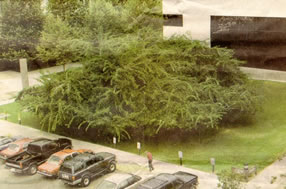Historic Tree
Ulmus Americana is the name of the rare tabletop elm tree that spreads its branches over the entire south lawn of the Utah County Administration Building. The 83 year old tree (in 2010) has outlived its other city tree counterparts many times over, despite onslaughts from flower beds, ditch diggers, building construction, microbursts, ignorant branch-sitters, scale, and aphids.

As nearly as anyone can tell, the tree was planted in 1927, shortly after the Historic Utah County Courthouse building was completed in 1926. It was planted by Moroni Wilford (Roni) Christopherson of Spanish Fork, Utah, who was a Utah County employee for 27 years. He and Elmer Pulley were given the job by the County Commissioners to travel to Ogden for the purpose of purchasing trees and plants for the then new courthouse building. While there, the nursery owner gave Roni the rare elm tree as a gift. It was said the elm was an experimental tree created by budding different trees together and the gift-giver called the tree a Weeping American Elm. The nursery owner came to Provo several times to check the elm during its tender years.
That the tree is rare is echoed by former County Engineer, Clyde Naylor, who indicated that it is the only known tree of its kind in the United States. Landscape experts have not been able to find another one like it. Additionally, the tree has never been successfully cloned or reproduced. Seedlings from the tree have not grown into the same kind of tabletop shape.
The tree is protected, having been one of the first trees to be named a Utah Heritage Tree when that program began in the 1980's. That means the Utah Community Forest Council must be consulted first whenever decisions are made that might affect the tree. The tree is well cared for by multiple County employees who nurture and oversee it daily and have even gone so far as to import thousands of ladybugs to eat unsuspecting aphids. The tree produces seven dump truck loads of fallen leaves every autumn and the heavy branches are supported by specialized braces which allow movement and growth.
In May of 2000, the County Commission unveiled a monument telling about the tree and its long history. Members of Roni Christopherson's family were instrumental in seeing the monument project through to fruition.
